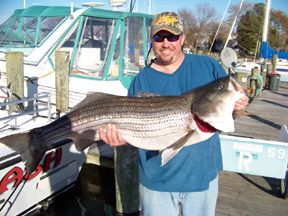Chesapeake Bay's Independent Newspaper ~ Since 1993
1629 Forest Drive, Annapolis, MD 21403 ~ 410-626-9888
Volume XVII, Issue 47 ~ November 19 - November 25, 2009
Home \\ Correspondence \\ from the Editor \\ Submit a Letter \\ Classifieds \\ Contact Us
Dining Guide \\ Home & Garden Guide \\ Archives \\ Distribution Locations \\ Advertising
![]()


 |
|
|
Back on the Chesapeake
There’s no place like home
I spent half of October and the first part of November chasing pheasants, grouse and other upland birds in Canada and South Dakota. Now I was back in Maryland and on the Chesapeake with a rod in my hand.
The weather had gentled enough to get out on the water, but my day seemed to bring nothing but disappointment. My attempts at white perch were a washout; I couldn’t find anything on shallow water structure to save my life.
The rockfish were just as elusive. All the fishing patterns had changed in my absence. That sinking feeling was coming over me — until I saw the gulls in the distance.
There were just a few at first. Then bunches of the artful dodgers materialized. In just minutes there were 50 or 60 of them dipping up bounty driven to the surface by feeding fish.
The day was calm, and it was easy to see the boils and splashes on the water under the birds. It had to be stripers; the blues were long gone south. I fired up my tired old Evinrude and headed straight for them.
I cut the engine about 100 yards out and switched to my electric motor. Mid-Bay fish, particularly the larger ones, can be spooked by motor noise. Easing up to casting distance, I sent a surface plug chasing after the nearest boil.
A dozen or so casts later, I finally hooked up. Reeling in my first thrashing striper, I judged it to be about 14 inches. It could barely get half the lure in its mouth. Another dozen casts netted just one more of identical size. It looked like I was in the midst of midgets.
A 23-foot Grady trolling around the edge of the action was having better luck with the big ones. One of its anglers, noticing me bobbing about without success, pointed emphatically down, then held his hands wide apart. The bigger fish were deep. Another boat dragging deep-set lines passed me a few minutes later, and its occupant gave me a wave as he put a sizeable striper in the cooler.
Vertical Jigging
I had no trolling gear, but I knew I could get at the fish by vertical jigging. First I had to recall the basics: Find the fish with your electronic fish finder; get a one-to-two-ounce jig to the bottom fast. Work it up through the school in short lifts and drops, being especially careful to feel the dropping side of the retrieve. That’s when the strike is most likely to occur.
I rigged a one-ounce, seven-inch Bass Assassin in Chartreuse Glitter, one of the more reliable deep-water patterns on the Bay — at least for me. I relaxed and looked around; the birds had started up again a few hundred yards away.
Slowly on approaching the down-tide side, I again marked good fish on my finder. Easing my sparkling lure over the side, I fed out line until it slacked as it hit bottom, then put my reel in gear and began a twitching, vertical retrieve. With an eye on my finder monitor, I watched the depth of the larger marks and tried to keep my lure moving up and down through that part of the water column.
Then as I was dropping the lure back, I felt a small thump. I quickly and gently lifted my rod tip. When I felt resistance, I set the hook, hard. That jig was 45 feet down.
My rod bowed over with a nice fish, my reel drag groaned in protest and that old, comfortable sensation blossomed in my bones. The sun was shining, the salty, autumn air was in my nostrils and I was home again on the Chesapeake. That’s a wonderful feeling.
Fish Are Biting
Schools of rockfish are feeding throughout the main stem of the mid-Bay. Watch for birds either in the air or sitting on the water to locate fish. Deep jigging or trolling are the best methods of scoring on these constantly moving concentrations of stripers. If there are small fish on top, there are often bigger ones underneath. Work the bottom on the down-current edges.
Perch, many of them big, are schooling in 45 to 60 feet of water over shell bottom and taking bloodworms. To the south, boats have been getting winter-sized rockfish to almost 50 pounds. Trolling from Buoy 78 and down to the Gas Docks with chartreuse or white sassy shads is doing the trick.
In Season
Whitetail deer firearms season opens November 28 and runs two weeks. In the last two months, bow and muzzle-loader hunters have already taken 24,384 deer statewide.
Canada goose hunting season runs November 21 to 27 and December 17 to January 30. Regular duck and sea duck season runs November 21 to 27 and December 15 to January 30.
For details check the DNR link: www.dnr.state.md.us/huntersguide/pdfs/Hunting_Seasons_Calendar.pdf.
© COPYRIGHT 2009 by New Bay Enterprises, Inc. All rights reserved.
